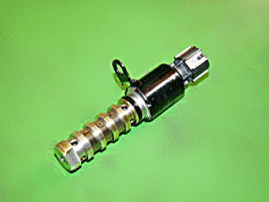Hyundai Sonata LF: Engine Control System / CVVT Oil Control Valve (OCV) Description and Operation
Hyundai Sonata LF 2014-2019 Service Manual / Engine Control / Fuel System / Engine Control System / CVVT Oil Control Valve (OCV) Description and Operation
| Description |
Continuous Variable Valve Timing (CVVT) system advances or
retards the valve timing of the intake and exhaust valve in accordance
with the ECM control signal which is calculated by the engine speed and
load.
By controlling CVVT, the valve over-lap or under-lap occurs,
which makes better fuel economy and reduces exhaust gases (NOx, HC) and
improves engine performance through reduction of pumping loss, internal
EGR effect, improvement of combustion stability, improvement of
volumetric efficiency, and increase of expansion work.
This system consist of
-the CVVT Oil Control Valve (OCV) which supplies the engine
oil to the cam phaser or cuts the engine oil from the cam phaser in
accordance with the ECM PWM (Pulse With Modulation) control signal,
- the CVVT Oil Temperature Sensor (OTS) which measures the engine oil temperature,
-and the Cam Phaser which varies the cam phase by using the hydraulic force of the engine oil.
The engine oil getting out of the CVVT oil control valve
varies the cam phase in the direction (Intake Advance/Exhaust Retard) or
opposite direction (Intake Retard/Exhaust Advance) of the engine
rotation by rotating the rotor connected with the camshaft inside the
cam phaser.

 Purge Control Solenoid Valve (PCSV) Repair procedures
Purge Control Solenoid Valve (PCSV) Repair procedures
Inspection 1. Turn the ignition switch OFF. 2. Disconnect the PCSV connector. 3. Measure resistance between the PCSV terminals 1 and 2. 4...
Other information:
Hyundai Sonata LF 2014-2019 Service Manual: Oil Pump Repair procedures
Removal and Installation 1. Remove the timing chain cover. (Refer to Timing System - "Timing Chain Cover") 2. Remove the pump cover (A). Tightening torque : 8.8 ~ 13.7N.m (0.9 ~ 1.4kgf.m, 6.5 ~ 10.1 lb-ft) 3. Remove the inner rotor (B) and outer rotor (C)...
Hyundai Sonata LF 2014-2019 Service Manual: Blind Spot Detection Unit Repair procedures
Removal 1. Disconnect the negative (-) battery terminal. 2. Remove the rear bumper. (Refer to Body - "Rear Bumper") 3. Remove the BSD unit (A) after loosening the mounting nuts. Take care not to separate the bracket from rear bumper when removing the BSD sensor...
Categories
- Manuals Home
- Hyundai Sonata Owners Manual
- Hyundai Sonata Service Manual
- Lighting System
- Air Conditioning System
- Engine Control System
- New on site
- Most important about car
Copyright © 2025 www.hsonatalf.org

